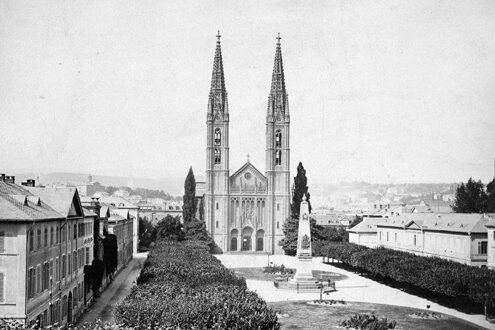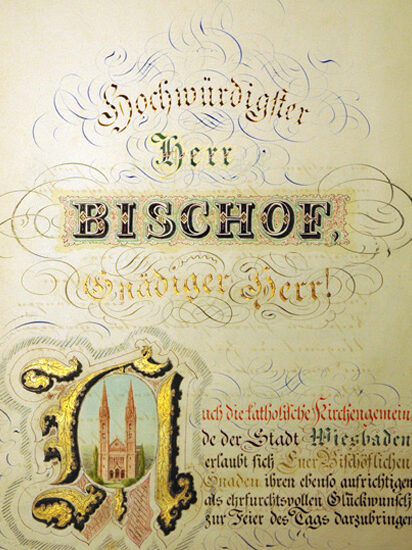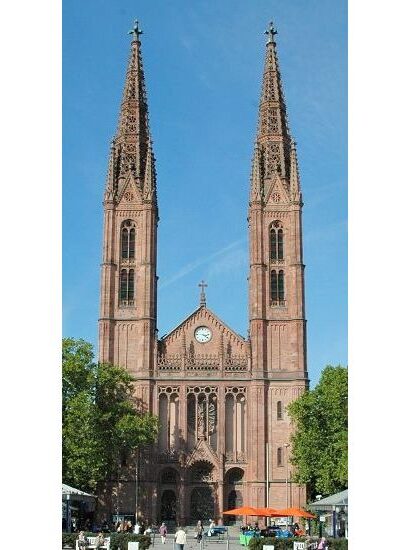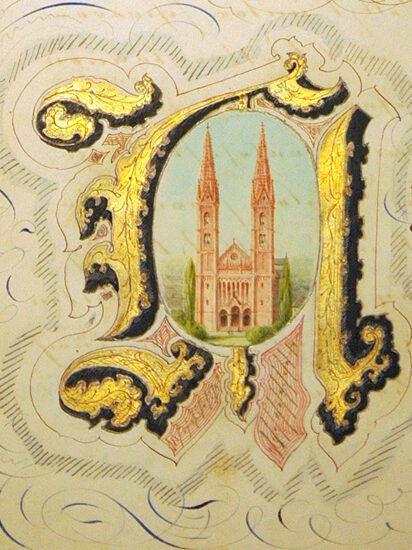St. Boniface
The Catholic church of St. Boniface was built by Wiesbaden architect Philipp Hoffmann and consecrated by the Bishop of Limburg in 1849. It is the oldest church in the city center.
The church of St. Boniface is the central parish church of the parish of St. Boniface and also the Catholic city church of Wiesbaden. Built mainly in neo-Gothic style between 1844 and 1849, it is the oldest church in the city center. The south-facing main façade forms the end of Luisenplatz. In contrast to its neoclassical predecessor, which was designed in 1827 by the Nassau court architect Friedrich Ludwig Schrumpf as a sculptural, all-view building, the Bonifatiuskirche is an architectural image conceived towards the square.
Built from 1828 in the shape of a truncated cross, the church designed by architect Schrumpf had a rotunda supported by twelve marble columns inside. A columned portico with an open staircase and two towers completed the appearance of this architecture, which collapsed on the evening of February 11, 1831, before it could have been consecrated. The work had probably been done in too much haste and with poor building materials.
After Duke Wilhelm von Nassau had already abandoned the plan to build his palace on the site on Luisenstraße, his son, Duke Adolf von Nassau, gave the old building site back to the parish. A statue of Archbishop Adolf I of Mainz, Count of Nassau (1353 - 1390), inside the church is a reminder of this support for the church by the ducal family. On May 24, 1843, Duke Adolf commissioned Philipp Hoffmann, a senior architect, to plan and build a new church.
The foundation stone was laid on June 5, 1845, on St. Boniface's Day. When the building was consecrated by Peter Joseph Blum, Bishop of Limburg, on June 19, 1849, neither the interior nor the main façade facing Luisenplatz had been completed. The bells were hung in pavilion-like bell houses made of slated wood on the tower stumps.
The 68-metre-high towers have only enclosed the much lower nave since 1866, which opens up to visitors with three portals. An eyelash pediment rises above the central one, with the dove of the Holy Spirit hovering in the middle. A figure of the Good Shepherd crowns this pediment. The original sculpture is now on the outside of the apse.
The "Pastor bonus", the figure of the Good Shepherd, is backed by fine tracery that lies like a curtain in front of the actual outer wall, which is pierced by a large wheel window. The sculpture marks the exact center of this stone veil. This principle of multiple shells, the dissolution of the wall in relation to the closed surface of the towers, the balance between a lively and calm formal language, but also between vertical and horizontal accents characterize the appearance of St. Boniface's Church. For Hoffmann, the ornamentation not only has a structurally organizing function, it was also an expression of a spiritual penetration of the building.
An electric clock has been installed in place of a second, smaller rose window since 1890. The open spires, modeled on the Freiburg Cathedral, are decorated with clay crabs and cross flowers with bull heads from the Wiesbaden ceramics workshop of Johann Jacob Höppli. The core masonry of the church consists of quarry stones from the quarries between Sonnenberg and Rambach and is plastered in ochre. Only the main façade is made of reddish Main sandstone from quarries near Böttingen and Aschaffenburg.
The interior of the three-nave, net-vaulted hall building is given a remarkable expanse by the wide transept, which also has three naves. The church suffered severe damage during the Second World War, particularly on the night of February 2, 1945. It was not until Christmas 1949 that the first restoration work was completed. After the Second Vatican Council, a fundamental renovation was carried out in 1965 by the Wiesbaden architect Paul Johannbroer. The original glazing with figurative motifs in dark red and blue tones was replaced by windows based on designs by the painter and glass artist Johannes Beeck (1927 - 2010), executed by the Derix company in Taunusstein. They depict the work of the Holy Spirit in today's world.
The design of the altar and ambo (1978) follows designs by the Cologne sculptor Elmar Hillebrand (*1925). The crucifixion group by the Biebrich sculptor Karl Hoffmann (1816 - 1872) has been preserved from the former high altar, which was executed in white-grey sandstone and furnished with eleven figures. The sculptures of St. Theresa of Ávila and St. Francis of Assisi in the choir, which commemorate two important benefactors of the church, Count Franz Philipp Wilderich von Walderdorff and Princess Therese of Oldenburg, a sister of Duke Adolf of Nassau, are also by his hand and originate from this context.
Two of the former four side altars have been preserved: The altarpieces depict the church patron St. Boniface, created by Alfred Rethel in 1847/48, and a Mother of God with Child (1849) by Eduard von Steinle. Today, the altar of the Sacred Heart and the altar of Our Lady of Sorrows are missing. Of the latter, the vesper image, the Pietà, from around 1860 has been preserved. The slightly recessed chapels, the baptistery in the west and the sacrament chapel in the east, were painted by Elmar Hillebrand in 1985. The capitals were made by his pupil, the sculptor Walter Hutz, between 1981 and 1990. The Chapel of the Blessed Sacrament was once the place where the wife of Duke Adolf of Nassau, Elisabeth Mikhailovna, niece of Tsar Nicholas I, who died in 1845, and the body of her daughter found their temporary resting place after the destruction of the Mauritius Church in 1850 until the Russian Chapel on the Neroberg could be consecrated in 1855.
The original ceramic Stations of the Cross purchased in Cologne limestone were not preserved. It had a colored version by Jakob Sturm, who had also been entrusted with the former painting of the church interior. In 1991, it was replaced by a work made of the same material by the sculptor Lore Friedrich-Gronau (1908 - 2002), created in the workshops of the Benedictine Abbey of Münsterschwarzach. The organ was rebuilt in 1985 by the Hugo Mayer company from Heusweiler in Saarland using the existing pipe material.
Liturgical instruments, missals and vestments are kept in the treasury of St. Boniface, including a Bible printed in 1571, a magnificent processional canopy executed in needle painting in 1899 and a tower monstrance from around 1900, which was enriched with donated jewelry in the 1930s.
Literature
- Hembus, Julius
The Bonifatius Church in Wiesbaden. Report on the building and church history from 1843 to 1849, Frankfurt a. M., Kronberg i. T. 1977.
- Czysz, Walter
Catholic parish church of St. Boniface Wiesbaden, Munich 1992.
- Sattler, Siegbert
Church of St. Boniface, 1843 - 1866, in: Philipp Hoffmann (1806 - 1889). A Nassau master builder of historicism. Worksheets of the State Office for Monument Preservation Hesse (ed.), vol. 12, Stuttgart 2007 (pp. 126-131).





